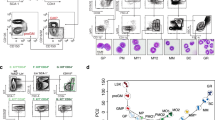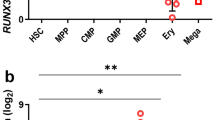Abstract
The balance between hematopoietic progenitor commitment and self-renewal versus differentiation is controlled by various transcriptional regulators cooperating with cytokine receptors. Disruption of this balance is increasingly recognized as important in the development of leukemia, by causing enhanced renewal and differentiation arrest. We studied regulation of renewal versus differentiation in primary murine erythroid progenitors that require cooperation of erythropoietin receptor (EpoR), the receptor tyrosine kinase c-Kit and a transcriptional regulator (glucocorticoid receptor; GR) for sustained renewal. However, mice defective for GR- (GRdim/dim), EpoR- (EpoRH) or STAT5ab function (Stat5ab–/–) show no severe erythropoiesis defects in vivo. Using primary erythroblast cultures from these mutants, we present genetic evidence that functional GR, EpoR, and Stat5 are essential for erythroblast renewal in vitro. Cells from GRdim/dim, EpoRH, and Stat5ab–/– mice showed enhanced differentiation instead of renewal, causing accumulation of mature cells and gradual proliferation arrest. Stat5ab was additionally required for Epo-induced terminal differentiation: differentiating Stat5ab–/– erythroblasts underwent apoptosis instead of erythrocyte maturation, due to absent induction of the antiapoptotic protein Bcl-XL. This defect could be fully rescued by exogenous Bcl-XL. These data suggest that signaling molecules driving leukemic proliferation may also be essential for prolonged self-renewal of normal erythroid progenitors.
This is a preview of subscription content, access via your institution
Access options
Subscribe to this journal
Receive 50 print issues and online access
$259.00 per year
only $5.18 per issue
Buy this article
- Purchase on Springer Link
- Instant access to full article PDF
Prices may be subject to local taxes which are calculated during checkout






Similar content being viewed by others
References
Bauer A, Gandrillon O, Samarut J, Beug H . (2001). Hematopoiesis: a developmental approach. Zon L (ed). Oxford University Press: Oxford, pp 368–390.
Bauer A, Tronche F, Wessely O, Kellendonk C, Reichardt HM, Steinlein P et al. (1999). Genes Dev 13: 2996–3002.
Beug H, Bauer A, Dolznig H, von Lindern M, Lobmayer L, Mellitzer G et al. (1996). Biochim Biophys Acta 1288: M35–M47.
Beug H, Dahl R, Steinlein P, Meyer S, Deiner E, Hayman MH . (1995). Oncogene 11: 59–72.
Blau HM, Brazelton TR, Weimann JM . (2001). Cell 105: 829–841.
Broudy VC . (1997). Blood 90: 1345–1364.
Carotta S, Pilat S, Mairhofer A, Schmidt U, Dolznig H, Steinlein P et al. (2004). Blood 104: 1873–1880.
Cole PJ, Blendy JA, Monaghan AP, Kriegelstein K, Schmid W, Aguzzi A et al. (1995). Genes Dev 9: 1608–1621.
Cui Y, Riedlinger G, Miyoshi K, Tang W, Li C, Deng CX et al. (2004). Mol Cell Biol 24: 8037–8047.
Dolznig H, Bartunek P, Nasmyth K, Müllner E, Beug H . (1995). Cell Growth Diff 6: 1341–1352.
Dolznig H, Boulme F, Stangl K, Deiner EM, Mikulits W, Beug H et al. (2001). FASEB J 15: 1442–1444.
Dolznig H, Habermann B, Stangl K, Deiner EM, Moriggl R, Beug H et al. (2002). Curr Biol 12: 1076–1085.
Dolznig H, Kolbus A, Leberbauer C, Schmidt U, Deiner EM, Mullner EW et al. (2005). Methods Mol Med 105: 323–344.
Doppler W, Geymayer S, Weirich HG . (2000). Adv Exp Med Biol 480: 139–146.
Dumon S, Santos SC, Debierre-Grockiego F, Gouilleux-Gruart V, Cocault L, Boucheron C et al. (1999). Oncogene 18: 4191–4199.
He LZ, Guidez F, Tribioli C, Peruzzi D, Ruthardt M, Zelent A et al. (1998). Nature Genet 18: 126–135.
Kieslinger M, Woldman I, Moriggl R, Hofmann J, Marine JC, Ihle JN et al. (2000). Genes Dev 14: 232–244.
Kolbus A, Pilat S, Husak Z, Deiner EM, Stengl G, Beug H et al. (2002). J Exp Med 196: 1347–1353.
Lacronique V, Boureux A, Valle VD, Poirel H, Quang CT, Mauchauffe M et al. (1997). Science 278: 1309–1312.
Li K, Menon MP, Karur VG, Hegde S, Wojchowski DM . (2003). Blood 102: 3147–3153.
Mikulits W, Chen D, Mullner EW . (1995). Nucleic Acids Res 23: 2342–2343.
Moriggl R, Gouilleux-Gruart V, Jahne R, Berchtold S, Gartmann C, Liu X et al. (1996). Mol Cell Biol 16: 5691–5700.
Moriggl R, Sexl V, Kenner L, Duntsch C, Stangl K, Gingras S et al. (2005). Cancer Cell 7: 87–99.
Motoyama N, Kimura T, Takahashi T, Watanabe T, Nakano T . (1999). J Exp Med 189: 1691–1698.
Neubauer H, Cumano A, Muller M, Wu H, Huffstadt U, Pfeffer K . (1998). Cell 93: 397–409.
Onnebo SM, Condron MM, McPhee DO, Lieschke GJ, Ward AC . (2005). Exp Hematol 33: 182–188.
Packham G, White EL, Eischen CM, Yang H, Parganas E, Ihle JN et al. (1998). Genes Dev 12: 2475–2487.
Pardal R, Clarke MF, Morrison SJ . (2003). Nat Rev Cancer 3: 895–902.
Parganas E, Wang D, Stravopodis D, Topham DJ, Marine JC, Teglund S et al. (1998). Cell 93: 385–395.
Reichardt HM, Kaestner KH, Tuckermann J, Kretz O, Wessely O, Bock R et al. (1998). Cell 93: 531–541.
Ren R . (2005). Nat Rev Cancer 5: 172–183.
Sawada K, Krantz SB, Dai CH, Koury ST, Horn ST, Glick AD et al. (1990). J Cell Physiol 142: 219–230.
Schulte CE, von Lindern M, Steinlein P, Beug H, Wiedemann LM . (2002). EMBO J 21: 4297–4306.
Schwaller J, Parganas E, Wang D, Cain D, Aster JC, Williams IR et al. (2000). Mol Cell 6: 693–704.
Shet AS, Jahagirdar BN, Verfaillie CM . (2002). Leukemia 16: 1402–1411.
Silva M, Benito A, Sanz C, Prosper F, Ekhterae D, Nunez G et al. (1999). J Biol Chem 274: 22165–22169.
Silva M, Grillot D, Benito A, Richard C, Nunez G, Fernandez-Luna JL . (1996). Blood 88: 1576–1582.
Socolovsky M, Fallon AE, Wang S, Brugnara C, Lodish HF . (1999). Cell 98: 181–191.
Stirewalt DL, Radich JP . (2003). Nat Rev Cancer 3: 650–665.
Teglund S, McKay C, Schuetz E, van Deursen JM, Stravopodis D, Wang D et al. (1998). Cell 93: 841–850.
Tenen DG . (2003). Nature Rev Cancer 3: 89–101.
Verdier F, Rabionet R, Gouilleux F, Beisenherz-Huss C, Varlet P, Muller O et al. (1998). Mol Cell Biol 18: 5852–5860.
von Lindern M, Deiner EM, Dolznig H, Hayman MJ, Muellner EM, Beug H . (2001). Oncogene 20: 3651–3664.
Von Lindern M, Schmidt U, Beug H . (2004). Cell Cycle 3: 876–879.
von Lindern M, Zauner W, Steinlein P, Mellitzer G, Fritsch G, Huber K et al. (1999). Blood 94: 550–559.
Wu H, Klingmuller U, Besmer P, Lodish HF . (1995). Nature 377: 242–246.
Yu H, Jove R . (2004). Nat Rev Cancer 4: 655–665.
Zang H, Sato K, Nakajima H, McKay C, Ney PA, Ihle JN . (2001). EMBO J 20: 3156–3166.
Acknowledgements
We thank H Reichardt and G Schütz for access to GRdim/dim mice, JN Ihle for Stat5ab–/–, EpoRH, and EpoRHM mice, and G Stengl and G Litos for expert technical assistance. This work was supported by the ‘Fonds zur Förderung der wissenschaftlichen Forschung, FWF’, Austria grant SFB F28 (to HB and EWM) and the Herzfelder Family Foundation (to EWM).
Author information
Authors and Affiliations
Corresponding authors
Additional information
Supplementary Information accompanies the paper on Oncogene website (http://www.nature.com/onc)
Rights and permissions
About this article
Cite this article
Dolznig, H., Grebien, F., Deiner, E. et al. Erythroid progenitor renewal versus differentiation: genetic evidence for cell autonomous, essential functions of EpoR, Stat5 and the GR. Oncogene 25, 2890–2900 (2006). https://doi.org/10.1038/sj.onc.1209308
Received:
Revised:
Accepted:
Published:
Issue Date:
DOI: https://doi.org/10.1038/sj.onc.1209308
Keywords
This article is cited by
-
Nucleated red blood cells explain most of the association between DNA methylation and gestational age
Communications Biology (2023)
-
Signal transducer and activator of transcription (STAT)-5: an opportunity for drug development in oncohematology
Oncogene (2019)
-
The role of glucocorticoid receptor in prostate cancer progression: from bench to bedside
International Urology and Nephrology (2017)
-
The Biological Functions of the Versatile Transcription Factors STAT3 and STAT5 and New Strategies for their Targeted Inhibition
Journal of Mammary Gland Biology and Neoplasia (2006)



